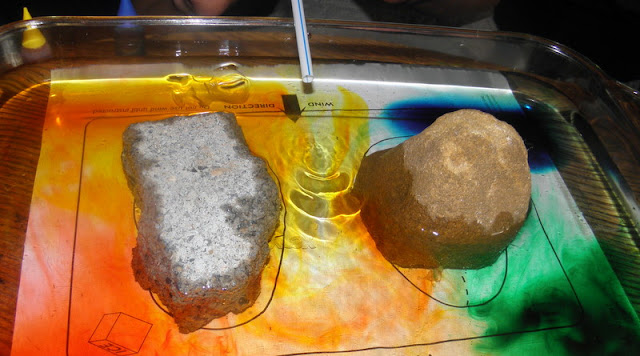Ocean Currents, Part I: Surface Currents {Wind & Temperature}
Wind sets the surface of the ocean moving, but other forces direct the flow into major gyres circulating clockwise in the Northern Hemisphere and counterclockwise in the Southern Hemisphere. Wind is one of the factors that cause currents. Another factor is the temperature of the water.
We did an experiment today showing how wind and cold temperature creates surface currents. To do this experiment, you will need a 9 x 13 baking pan, a package of liquid food coloring and some straws. Fill a 9 x 13 baking pan with about 1 inch of water and place it on a table. Put two large rocks to represent land masses on either side in the middle of the pan. If you wish, you can slip a copy of the Pacific Rim map under the pan, but you will need to put you land masses at least an inch from the side of the pan. Put 4 drops of green, blue and red food coloring in 3 corners and 8 drops of yellow food coloring in the fourth corner.
Trying not to bump the dish, watch to see what the colors do for a few minutes. Some of them may spread a bit, but they in general will stay in their corners unless you make waves by bumping the dish.
Put an ice cube in one of the corners. We chose the upper right hand corner. The ice should create a bit of a current in this corner, blending the two colors on that side of the pan a bit.
Putting the straw level with the surface of the water at the opposite side, blow lightly through the straw to create a current. You can get your students to record what they observe on the, with labels and arrows for direction of water and wind. This model simulates how winds set the surface water flowing in the same direction as wind. If you have trouble seeing the currents, you can make it more clear by making some plastic confetti by coloring with a permanent marker about a 4 inch square of a plastic sandwich bag. Cut this into about 20- 1/4 inch squares. Drop 10-15 plastic pieces that you have colored into the pan and ask students to observe. Hold the straw as you did before. If you are doing it right the current should be centered so that the plastic pieces deflect both right and left. The two circular currents, one clockwise in the Northern Hemisphere and the other clockwise in the Southern Hemisphere. These are gyres. Winds near the equator, called the trade winds, generally blow from east to west, causing east to West Equatorial Current. Draw this current on your own map with labels.
Using the straw as before, but position it so it can blow towards the rock. You will see turbulence, complicated and constantly changing swirling motion, as well as eddies and counter-currents forming around the island. Discuss how complicated currents can become where there are obstacles.
Now you can look at a picture of surface ocean currents. Based on what you saw in the pan, can you see how they are formed?
You can discuss how waste disposal in the water from any country can affect the whole world. Pretend the colors were different types of waste disposal. By the end, they were all mixed all over the pan.
GEMS: Ocean Currents
Grades 5-8
7 Activities
Students gain fascinating insights into our ocean planet through these innovative activities. They learn how wind, temperature, salinity, and density set water into motion, and they make an “in-depth” investigation of the key physical science concept of density. They model how pollution dumped in one location can spread throughout the ocean. Learning is placed in a real-world context as students predict and analyze routes taken by shipwrecked sailors, the 1990 Nike shoe spill, the raft Kon Tiki, and other voyages. In “Message in a Bottle,” students create stories to show what they've learned over the course of the unit.
Grades 5-8
7 Activities
Students gain fascinating insights into our ocean planet through these innovative activities. They learn how wind, temperature, salinity, and density set water into motion, and they make an “in-depth” investigation of the key physical science concept of density. They model how pollution dumped in one location can spread throughout the ocean. Learning is placed in a real-world context as students predict and analyze routes taken by shipwrecked sailors, the 1990 Nike shoe spill, the raft Kon Tiki, and other voyages. In “Message in a Bottle,” students create stories to show what they've learned over the course of the unit.





